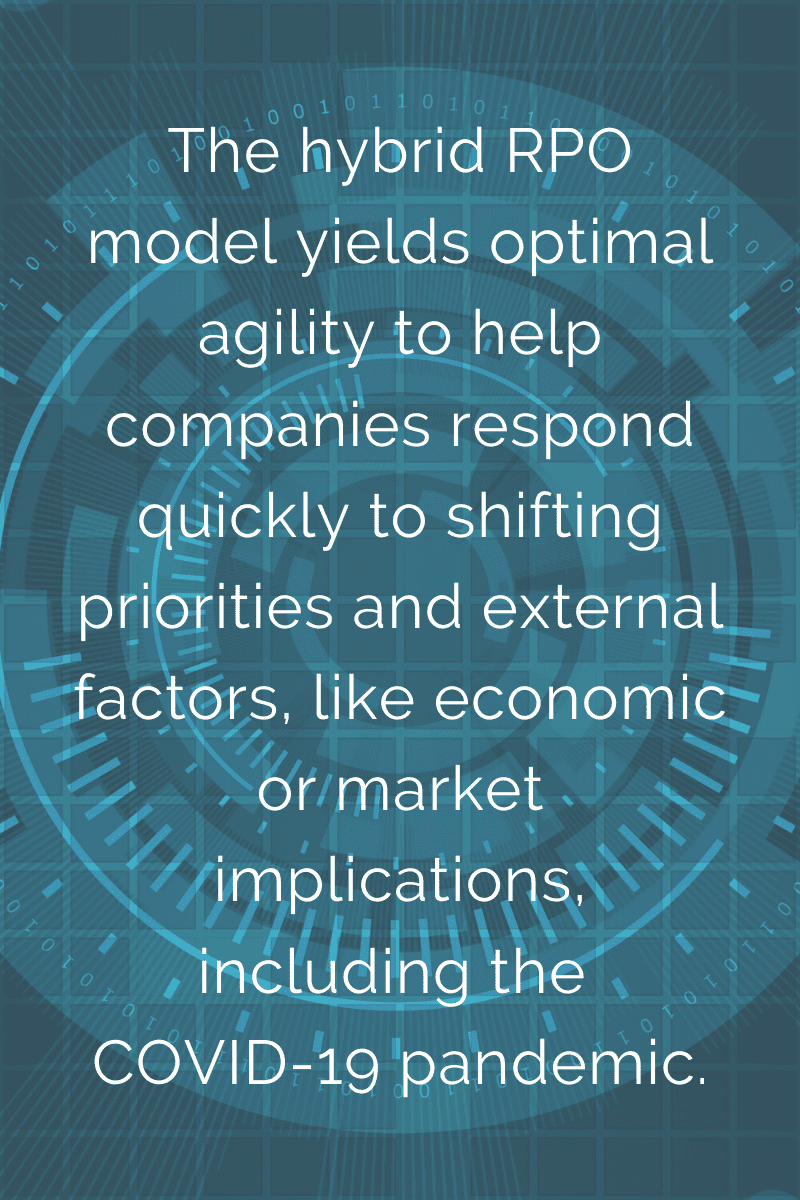Organizations that leverage a hybrid RPO partnership gain talent acquisition flex and scale for challenging times.
By Tierney McAfee
Depending on the industry, most organizations are looking across their business to understand where they can either cut costs or bolster support for critical operations in response to the COVID-19 pandemic. Built-in scalability or flexibility during times like these helps companies implement any needed changes quickly -and with less disruption to the business. While this applies to any business function, it’s especially impactful for talent acquisition.
Even before the current situation, more talent acquisition leaders were increasingly turning to a hybrid model for talent acquisition. It allowed them to enjoy the benefits of both insourced and outsourced recruiting models. Continuity, strong relationships, and business knowledge could be preserved by internal TA experts, complemented by the subject matter expertise and flexibility provided by an outside partner.
Right now, the market is seeing many organizations freeze hiring for financial reasons and to support the health and well-being of candidates and employees. At the same time, other organizations are looking to hire tens of thousands of new employees to support important operations; these organizations in critical industries are facing drastic increases in demand for their products or services that serve public health needs.
With either shift in hiring strategy, a Hybrid RPO model allows talent acquisition leaders to successfully manage change and their stakeholders’ experience and expectations. With an expanded knowledge base and experience, organizations can leverage their own internal resources to deliver on strategic business priorities while the RPO provider scales up or down to support ongoing recruitment needs.
“An organization benefits not only from having this extension that gives you scalability, but also from the overall knowledge base of an RPO provider that can share best practices from working with multiple customers,” says Josh Needle, the senior vice president of client services at Cielo, the world’s leading strategic recruitment process outsourcing (RPO) partner.
“The hybrid RPO model yields optimal agility to help companies respond quickly to shifting priorities or external factors, like economic or market implications – like what we are seeing currently with COVID-19. With hybrid models, TA leaders have a variable cost structure, giving them the ability to scale external resources as needed for workload fluctuations, without having to quickly staff-up or make tough decisions to reduce headcount.”
Technology’s Role
In addition to scalability and improved allocation of resources, technology is another reason organizations are increasingly moving to hybrid RPO. New waves of HR technology are helping TA and HR leaders implement blended strategies with approaches that are both easier and more effective.
“Talent acquisition leaders are feeling empowered with the continued innovation and new product offerings within the recruitment tech space,” explains Jonathan Gottlieb, vice president at Cielo.

“In years past, there has been more comfort in allowing a partner to operate with a disparate set of tools and technologies and even processes,” he explains. “But now we’re seeing a drive across the market for creating more consistent dashboards and experiences within the entire TA function, for both in-house and outsourced. And to do that you need to be playing from the same deck and have access to the same tools.”
Sometimes that means the RPO partner plugging into and optimizing the organization’s existing recruiting technology systems, while other times, organizations will look to RPOs like Cielo to bring a more holistic tool set or additional plug-ins to share with the internal team.
“When there’s a consistent set of shared tools and one key system of record, we can ensure the teams are delivering similar experiences for hiring managers, candidates and HR leadership, and, not least importantly, have one source of truth when looking at KPIs and building holistic recruitment dashboards. With shared technology and performance measures we create that one-team mentality that’s a recipe for success.”
Looking Ahead
Hybrid RPO is setting new standards for the industry, but creating a successful model takes the right approach and planning. Gottlieb and Needle recommend clearly outlining roles and responsibilities between the internal and external team as the first step in the process. This helps avoid confusion or any sense of division between the client and the partner.
“The key is for a business and an RPO provider to work together to create a one-team mentality,” Needle adds. “We say we’re partners, and we don’t take that commitment lightly. We’re all there to do the same job and that’s to find the best candidates as quickly as possible and provide a great candidate and hiring manager experience.”
“It can take a lot of discussion and planning at the outset to get that right,” Gottlieb says. “But when we get it right and we have clear swim lanes, then the collective horsepower of the teams really accelerates the ability to reach the organization’s business goals, together.”














